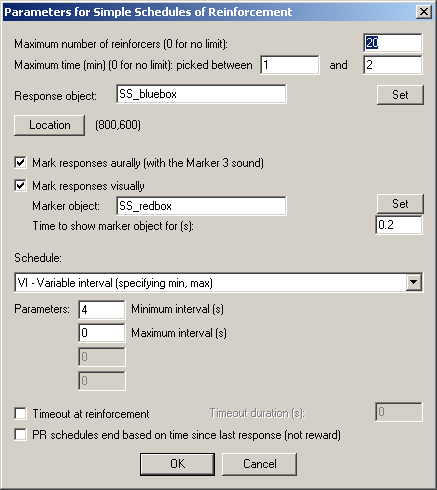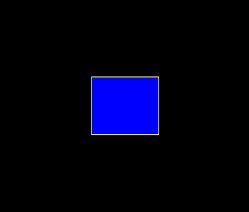|
About the task
Schedules of reinforcement using a touchscreen manipulandum.
Configuring the task
What constitutes "a reinforcer" is defined in the General Parameters. This allows you to set the reward sound and define what sound is associated with the presentation of a reward.

| • | Maximum number of reinforcers. Once this number of rewards has been delivered, the task stops. (Specify 0 for no limit.) You must specify either a maximum number of rewards, or a maximum time, or both. |
| • | Maximum time (min). Once this time limit has been reached, the task stops. (Specify 0 for no limit.) You must specify either a maximum number of rewards, or a maximum time, or both. |
| • | Response object. The picture that the subject has to touch. Click Set to choose an object from the visual object library. |
| • | Mark resposes aurally. If this is selected, the Marker 3 sound will be played to inform the subject that it has touched the picture successfully. (The schedule pauses while this sound is played.) |
| • | Mark responses visually. If this is selected, you may replace the response object with another picture for a brief period of time, to indicate visually that the subject has made a successful response. The marker object is shown here; click Set to choose one from the visual object library and choose the Time to show marker object for (s). The schedule is paused while the marker object is being shown. |
| • | Schedule. Choose the schedule, and up to three parameters associated with the schedule. The schedules are: |
| • | CRF - continuous reinforcement (FR-1). One reinforcer per response. |
| • | EXT - extinction. No reinforcers. |
| • | FR x - fixed ratio. One reinforcer per x responses. |
| • | VR x to y - variable ratio (specifying min, max). After a variable number of responses (randomly chosen from min to max inclusive), one reinforcer is delivered. |
| • | RR x - random ratio. P(reinforcer | response) = 1/x. |
| • | PROB p - probabilistic. P(reinforcer | response) = p. |
| • | FI x - fixed interval. The first response after x seconds is reinforced. The first response of the schedule is also reinforced. |
| • | RI x - random interval. Reinforcement is set up on a random-time schedule (see below); after reinforcement has been set up, the next response is reinforced. |
| • | VI x to y - variable interval (specifying min, max). After a variable time (from min to max seconds), the next response is reinforced. |
| • | FT x - fixed time (NONCONTINGENT). No object is shown on the screen. Reinforcement is delivered every x seconds. |
| • | VT x to y - variable time (specifying min, max) (NONCONTINGENT). No object is shown on the screen. The schedule waits for between min and max seconds, then delivers a reinforcer, then repeats. |
| • | RT x - random time (NONCONTINGENT). No object is shown on the screen. Every second, p(reinforcer delivered this second) = 1/x. Thus, on average, reinforcement is delivered once every x seconds, but the subject cannot predict the likelihood of reinforcement based on how long it has waited (unlike a typical VT schedule). |
| • | PR - progressive ratio - add one (1,2,3,4...) - progressive ratio schedule, adding one to the ratio requirement at each step. The schedule termination is determined by the parameter; if parameter is >0, then when parameter minutes have elapsed since the last reinforcer, the schedule stops. I suggest 60 as a sensible value. Progressive ratio schedules were invented by William Hodos [Hodos W (1961); Progressive ratio as a measure of reward strength, Science 134: 934-944]. |
| • | PR - progressive ratio - double (1,2,4,8...) - progressive ratio schedule, doubling the ratio requirement at each step. The schedule termination is determined by the parameter; if parameter is >0, then when parameter minutes have elapsed since the last reinforcer, the schedule stops. I suggest 60 as a sensible value. |
| • | PR - progressive ratio - Fibonacci (1,1,2,3,5...) - progressive ratio schedule with a Fibonacci progression. The schedule termination is determined by the parameter; if parameter is >0, then when parameter minutes have elapsed since the last reinforcer, the schedule stops. I suggest 60 as a sensible value. |
| • | PR - progressive ratio - Roberts exponential (A * exp(reinfnum * B) - A) - progressive ratio schedule with an exponential progression, based on Roberts DCS & Richardson NR (1992), Self-administration of psychomotor stimulants using progressive ratio schedules of reinforcement, Neuromethods 24: 233-269 (eds Boulton A, Baker G, Wu PH; Humana Press). The ratio requirement is (A * exp(reinforcer number * B)) - A, rounded to the nearest integer. Typically, A is 5. A typical schedule might have B=0.2; these values yield ratio requirements {1, 2, 4, 6, 9, 12, 15, 20, 25, 32, 40, 50, 62, 77, 95, 118, 145, 178, 219, 268, 328, 402, 492, 603, 737, 901, 1102, 1347, ...}. A steeper PR schedule is obtained with B=0.25, giving {1, 3, 6, 9, 12, 17, 24, 32, 42, 56, 73, 95, 124, 161, 208, 268, 346, 445, 573, 737, 948, 1218, 1566, 2012, 2585, 3321, 4265, 5478, ...} The schedule termination is determined by the other parameter (on the left, labelled (min)); if this parameter is >0, then when this many minutes have elapsed since the last reinforcer, the schedule stops. I suggest 60 as a sensible value. |
| • | DELAYFR1 - FR1 with delayed reinforcement. This is an FR1 schedule, but there is a delay between responding and reinforcement. This delay is the sole parameter (specified in seconds). |
Special case: the first response on contingent interval schedules (FI, RI, VI) is always reinforced.
For noncontingent schedules, nothing is shown on the display.
See also Notes on reinforcement timing.
Screenshot from the task

|

